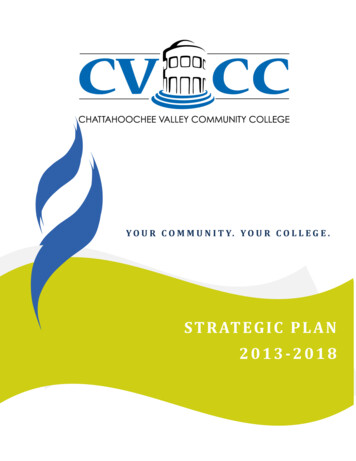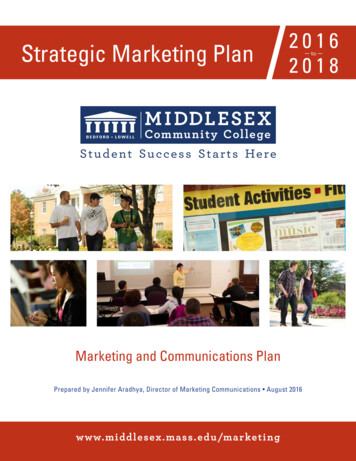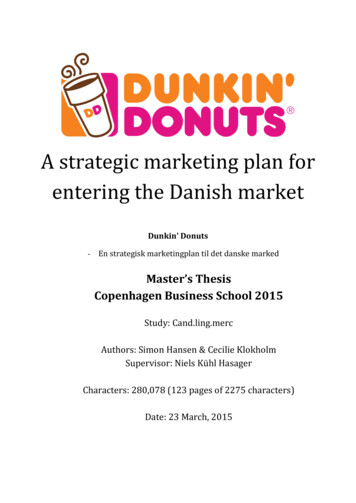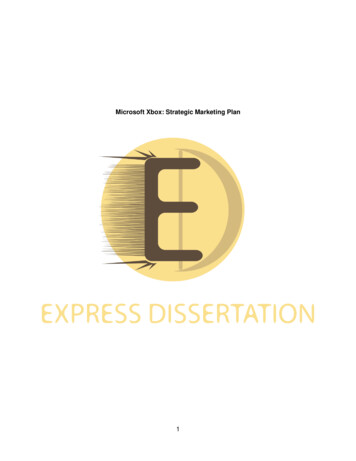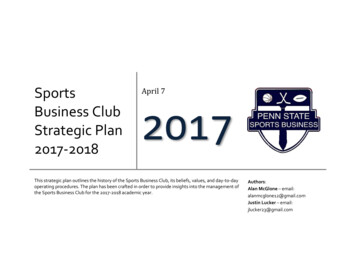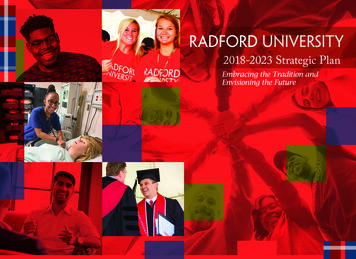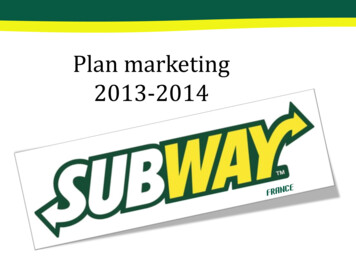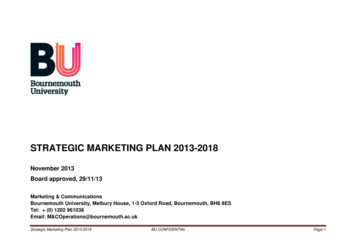
Transcription
STRATEGIC MARKETING PLAN 2013-2018November 2013Board approved, 29/11/13Marketing & CommunicationsBournemouth University, Melbury House, 1-3 Oxford Road, Bournemouth, BH8 8ESTel: (0) 1202 961038Email: M&COperations@bournemouth.ac.ukStrategic Marketing Plan 2013-2018BU CONFIDENTIALPage 1
CONTENTS1. Executive SummaryPage 32. Introduction and ContextPage 53. Marketing ObjectivesPage 103.1 Reputation BuildingPage 113.2 Student RecruitmentPage 133.3 Partnership DevelopmentPage 183.4 CommunicationsPage 204. Measurement and EvaluationPage 25APPENDICESASWOT Analysis of Marketing EnvironmentBStakeholder MappingCMarketing & Communications: Proposed Overarching StructureDStudent Recruitment: Performance DataEStudent Recruitment Delivery Plans detail: 2014/15FKey Messages and Proof PointsStrategic Marketing Plan 2013-2018BU CONFIDENTIALPage 2
1. Executive SummaryBournemouth University is on a journey to become a UK ranked top 50 university, by 2018. This marketing strategy sets out how taking astrategic approach to marketing and communications will support us on that journey.We have ambitious targets, set against a challenging and changing external environment. Growth in PGT and International student numbersrepresents a significant challenge, where we start from a low base. Developing effective partnerships will be key to long term success and weneed to be attractive to the ‘right’ partners for BU. Exploiting our existing industry and professional links and developing new ones is critical toachieving our student recruitment targets where employability is a key message. Attracting the right staff and students through showcasing thebest of BU, from research achievement to investment in our estates, infrastructure and the whole BU experience, will be central to success.Communicating BU’s distinctiveness, defined as Fusion in our strategic plan, is central to achieving a differentiated place in a crowded market.In our communications, we need to bring Fusion to life for each audience group. Evidence of what Fusion means for students, staff and ourwider community of stakeholders, is starting to emerge through innovative, varied and impactful projects and successes across the institutionand our communications must reach out and tell those stories in the language and through the channels our stakeholders want to hear anduse.Set out in this plan are four headline objectives to support reputation building, student recruitment and partnership development, allunderpinned by an effective and strategic approach to communications. Central to delivery is a high performing, creative and committedMarketing & Communications team, working in partnership with Academic Schools and Professional Services. Developing and investing in theMarketing & Communications team, who will be leading delivery of this plan, will be a priority during 2014, following a major review of structurein late 2013.Internally, marketing (as a function – not a department) needs to become integrated across the organisation and awareness of the role thatevery member of staff plays in building and living the BU brand and “delivering the promise” is critical. Internal communications and acollaborative approach to working will be prioritised within the Marketing & Communications directorate, which will lead on embeddingmarketing across the institution. The importance of internal communications is recognised in this plan: our staff and students are our potentialambassadors and word of mouth is, as ever, the most valuable promotional tool in recruiting students and building reputation.The gap between IT and marketing is closing and exploiting new technology and digital communications brings us an opportunity. Highlytargeted, data driven and personalised communications, measurement and analysis – digital technology gives us the chance to do this andStrategic Marketing Plan 2013-2018BU CONFIDENTIALPage 3
become more agile, innovative and cost effective in our marketing communications. Work on a new digital vision for our communications hasbeen undertaken in 2013 and this will now inform development of a fresh public facing website in 2014, to act as the cornerstone for ourcommunications.Priorities are to: Communicate what we stand for clearly. Stand out and be heard above the noise in a crowded market to build our reputationalawareness and understanding. We need to know the audience, listen and know how they want to be communicated with and when.Use the staff and student experience to tell the BU story.Keep the importance of word of mouth and BU staff and students at the forefront of our minds. Develop our internal communicationsand work to ensure all staff and students - the BU community - know and share our BU values, and that our behaviour does not conflictwith what we are saying in our communications.Exploit new and emerging technologies to constantly refine and improve our marketing and communications.Use market research and intelligence to develop insight and lead a more market informed approach to product development, targeting,segmentation and positioning.Know what’s working in our marketing and communications through measurement and analysis to make us agile, effective andaccountable.This strategic marketing plan is ambitious and achievable. It has BU values running through it and will demand creative approaches, usingauthentic voices, telling responsible messages. Pursuit of excellence must be a constant, with achievement celebrated and always present asthe goal. Delivery of the plan depends on the whole institution embracing the objectives and approach. It will be led by a strong Marketing &Communications team equipped with the right skills, from analytical thinking to creative ideas and everything in between. The team will beempowered to think and act strategically across BU, to deliver effective marketing and great service to internal and external stakeholders alike.Certainly the external environment is challenging and with a forward-looking, market informed approach BU will be well placed to achieve itsambitions as set out in BU2018.Strategic Marketing Plan 2013-2018BU CONFIDENTIALPage 4
2. Introduction and contextBournemouth University’s vision is to “create the most stimulating, challenging and rewarding university experience in a world-class learningcommunity by sharing our unique fusion of excellent education, research and professional practice and inspiring our students, graduates andstaff to enrich the world.” This strategy draws on this vision and the University’s Strategic Plan BU2018 and sets out overarching and strategiclevel marketing and communications objectives and strategies to support the achievement of BU2018.In turn, beneath this plan document, one year tactical plans detail the activities and campaigns required to deliver on these overarchingobjectives. This hierarchy of plans is shown here:BU2018Strategic Marketing Plan 2013-2018CorporateCommunications PlanInternationalMarketing & StudentRecruitment PlanUK Marketing &Student RecruitmentPlanThe supporting plans to this overarching marketing strategy are reviewed and updated annually, through the University’s delivery planningprocess. They contain full details of planned activity with time schedules and budgets. Academic School marketing plans are also produced atthis time, which draw on activities set out in the central plans shown above together with detailed School specific activities from the Schools’Strategic Marketing Plan 2013-2018BU CONFIDENTIALPage 5
annual Delivery Plans. These supporting plans form part of the Marketing & Communications departmental Delivery Plan and are available onrequest (or to view here I:\OVC\Public\BU Delivery Plans 2013-14\All DPs 2012-13\BU Delivery Plans 2012-13\Approved Delivery Plans).The University Executive Team has had significant input at all key stages throughout the development of this plan, and the UniversityLeadership Team has been consulted. This plan has also benefitted from invaluable professional and academic input and advice fromcolleagues in the Business School and the Media School.The external contextThe marketing context in which BU is operating is complex and continually evolving. A top level exercise to identify strengths, weaknesses,opportunities and threats highlights this point well and is included as Appendix A for reference.The competitive environmentCompetitive forces in UK higher education are increasing, whether through the growth in public and private higher education providers in theUK, alternative career paths for young adults, such as apprenticeships, or development of in-country provision in south-east Asia. Alternativeroutes to higher education, such as MOOCs (massive open online courses) or split provision across partner institutions and other forms oftrans-national education (TNE) have already fragmented the traditional target market segments. Internationally and domestically, increasinglyaggressive marketing tactics are being used to reach more sophisticated prospective students. The market place in the UK is noisy, with littleclear differentiation between institutions demonstrated for prospective students and their influencers in the home UK market. League tablepositions and statistics about employability dominate communications, but there is little evidence that these have impact on choice in the UKmarket (although there is clear evidence of their influence on international students). The need to demonstrate value for money and return oninvestment, particularly in the postgraduate market is likely to increase. A report from HEFCE (July 2013) highlights concern about the impactof increased debt incurred at undergraduate study level, combined with limited access to finance for UK postgraduate students.BU’s direct competitor set varies for each of our main target markets. For our largest (by volume) market, undergraduate home students, UCASdefines a competitor set of six institutions where our applicants also apply to study and a degree of change is seen in that set from year to year.Individual subject areas have their own direct competitors and these are monitored through BU managed Fresher and Decliner surveys. Thesecourse and framework level competitor sets are used to inform pricing policy for UK and non-UK markets.Strategic Marketing Plan 2013-2018BU CONFIDENTIALPage 6
CommunicationsAt the same time, technology is driving rapid changes in how and when people want to communicate and universities, not traditionally at theforefront of marketing communications developments, must respond and adapt to changing consumer behaviours and preferences driven bythese changes. The opportunities presented by digital communications are significant in the context of using data to target and reach the rightaudience at the right time, with the right message. There are challenges to consider - the first concerns organisational agility and cultural abilityto exploit new technology. The second is in the use of new technology, the data and intelligence it gives us access to and how to exploit thatinformation to gain insight and drive action – as opposed to simply increasing knowledge.Managing reputation has changed dramatically with the rise of social media and power and control lies increasingly with the user, student orcustomer. Word of mouth takes on even more importance. Effective communications are increasingly two-way and need to be available ondemand, on multiple and mobile platforms.With increasing choice and such a constantly evolving external marketing context, the BU brand and proposition needs to be clear and,crucially, needs to communicate what is distinct about BU - the reason to choose us over anyone else. This narrative must flow consistentlythrough all BU communications, both internal and external, to create a powerful and coherent corporate identity for the University.The internal contextDistinctiveness and the BU BrandAt the heart of our Strategic Plan, Fusion is what makes us different from our competitors. Communicating that concept in the right languageand then bringing it alive to give it meaning to our different audiences is the challenge for marketing and communications at BU. The use ofcase studies and stories to illustrate and make Fusion relevant to our stakeholders will be key.Our brand strategy is to maintain a strong ‘masterbrand’ architecture, represented by the current BU logo and visual identity, complemented bya degree of sub-branding, judiciously applied, in our areas of academic strength and excellence. Our strategy will be to ensure we develop acohesive and consistent branding of BU, without losing the individual personality of the constituent parts and allow our diversity, strengths andcharacter to show through our communications.Strategic Marketing Plan 2013-2018BU CONFIDENTIALPage 7
We need to recognise that there are myriad different elements which make up BU as a brand and which will vary in their resonance andimportance to different groups. The quality of our provision, our achievements, our location, estate, student support and the intangible andintrinsic essence of BU (our values and culture) all need to be presented as part of what makes BU unique. Further details of how wecommunicate through key messages are given in Section 3.4 of this document.The PortfolioThe need for market research to inform course and programme development is signalled in BU2018. Our strategy is to maintain a broadacademic footprint, but with a dynamic layer which will be “highly mobile, responding continually to market demand.” To inform new coursedevelopment, market research support in identifying new and emerging demand, assessing size and accessibility of market, audiencepreferences and market testing will be required. At the same time, identification of falling demand as courses reach maturity is required to drivean active approach to assessing on-going viability of courses without clear strategic fit and/or low demand.Early involvement and greater use of market intelligence in the early stages of new course development will be achieved through changes tothe level of marketing support provided to Academic Schools.Attractiveness of BU and promotional reachPerformance over the last five years in attracting students in our core markets is shown graphically in Appendix D and further context is given inSection 3 of this document. In summary, in the undergraduate UK market, BU has performed well, tracking well against competitors and thesector. In 2013/14 we exceeded our regulated student number and met our deregulated target number for attracting high calibre (ABB )students. BU’s share of the UK postgraduate market is small and in decline, mirroring the UK market decline (up to 2011/12, the latest point forwhich market data is available). Internationally, from a position of growth in international student enrolments between 2008/09 and 2010/11,the last two years have seen a decline in BU’s reach and attractiveness to postgraduates, with undergraduate numbers showing a slightincrease over the last five years.StructureBU has an established Marketing & Communications department which has overall responsibility for delivery of all marketing campaigns, PR,corporate communications, internal communications to staff and students, student recruitment and relationship marketing including handling ofinternational admissions. The existing structure of this function has grown somewhat organically in recent years and a review (October 2013)will propose a re-alignment of roles and responsibilities to better reflect and support the needs of BU2018 and this strategic marketing plan.Strategic Marketing Plan 2013-2018BU CONFIDENTIALPage 8
There is a base of good technical skills, institutional and market knowledge, creativity and commitment. We now need to become more agile,responsive and connected to leading market and marketing developments. Appendix C gives an overview of the proposed changes to theexisting structure.StakeholdersBU’s many and varied stakeholder groups are identified below. Communications with each group need to be tailored, planned and cohesive.They also need to take account of preferences in channel and delivery, consistent in message but tailored in language and tone. For eachheadline objective, work to prioritise communications with each group was undertaken in summer 2013 and is attached in Appendix 20.21.Current studentsProspective studentsStaffSUBUBoardGraduate employersAlumniEnd users of researchProfessional BodiesLocal communityLocal /regional councils/influencersStrategic Marketing Plan 2013-2018BU CONFIDENTIALBusiness community: regional/nationalSchools and Colleges: UKInternational agentsPartnerships: InternationalFeeder institutions: overseasPartner organisations: nationalParents of students/prospective studentsChancellerySuppliersNational HE policy influencersPage 9
3. Marketing objectivesFour overarching marketing objectives have been identified to support BU2018. The first three are interconnected while the fourth, communications, supportssuccessful achievement of the first rategic Marketing Plan 2013-2018BU CONFIDENTIALPartnershipDevelopmentPage 10
3.1Objective 1: Reputation buildingTo position BU to its stakeholders as a world-class learning community in its areas of academic strength, built on its core concept of Fusion and reflecting aleague table position within the top 50 UK universities.Measured by: Stakeholder perceptions of the BU brand and distinctiveness Achievement of relevant KPIs and measures. E.g. League table position, student recruitment targets met. Engagement and influence in Public Affairs and Thought LeadershipThe first of four headline objectives in BU’s strategic marketing plan 2013-18, reputation building is central to the achievement of BU2018. At the start ofmanaging and building that reputation, understanding awareness levels and, where there is awareness amongst our stakeholder groups, how we are viewedtoday is fundamental. Without understanding our starting point, we are making assumptions with no empirical underpinning and are at risk ofmisunderstanding our audiences. Research to understand reputational standing in key groups forms part of this plan.Central to BU’s Strategic Plan is a differentiation strategy (paragraph 2, BU2018 Executive Summary). With Fusion providing our distinctive proposition, wewill build our reputation through communicating and demonstrating Fusion in action, underpinned by academic and service excellence.3.1.1 Awareness buildingWe will continue to build on existing awareness of the Bournemouth University brand, drawing on areas of academic excellence across BU, on our areas ofresearch strength and its impact on society. We will develop tailored and sustainable communications plans to each target stakeholder group, using casestudies, student and staff voice and evidence based stories of Fusion in action. Key messages and communicating Fusion is set out more fully underObjective 4: Communications, Key Messages, below.Central to our messaging will be our achievement in the 2013 Quality Assurance Agency review and we will maximise the opportunity this presents to positionBU as ‘first for quality of student learning opportunities’, to all our stakeholder groups.Internal communications will be prioritised, recognising staff and students as central to delivering BU2018, with the potential to be our best ambassadors intelling the BU story.Strategic Marketing Plan 2013-2018BU CONFIDENTIALPage 11
An increased emphasis will be placed on planned corporate communications to priority stakeholder groups, (prioritisation shown in Appendix B). We will takea proactive approach to PR, focused on impact rather than inputs, using a targeted approach to the media. Thought Leadership in research, professionalpractice or
Strategic Marketing Plan 2013-2018 BU CONFIDENTIAL Page 1 STRATEGIC MARKETING PLAN 2013-2018 November 2013 Board approved, 29/11/13 . Marketing & Communications Bournemouth University, Melbury House, 1-3 Oxford Road, Bournemouth, BH8 8ES Tel: (
